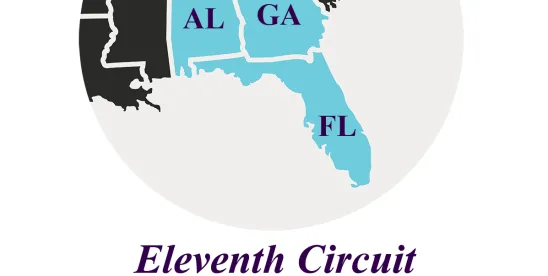In United States v. Mims, No. 22-13215, 2025 WL 1934570 (11th Cir., July 15, 2025), the Eleventh Circuit addressed a relatively straightforward question of first impression: “whether a district court continues to have jurisdiction in a criminal case to order compliance with unsatisfied restitution obligations after the defendant completes her probationary sentence.” In answering that question in the affirmative, the court effectively expanded the range of options available to the government to enforce restitution orders under the Mandatory Victims Restitution Act (MVRA).
While the holding breaks new ground, its legal effect is likely to be limited. The government typically enjoys options beyond the MRVA – including the criminal forfeiture statutes – when enforcing restitution obligations imposed in criminal cases. Those forfeiture statutes provide the government more aggressive and efficient options to seize and forfeit property, and thus are typically best suited to collect unsatisfied restitution obligations. While the opinion does not specify why the government did not pursue those options, or if they were even available, to collect the debt the defendant was ordered to pay, a deeper dive into the district court proceedings sheds some light on the issue.
That review reveals a series of unconventional pleadings filed by the defendant – an apparent sovereign citizen appearing pro se for much of the relevant time period – and suggests that the government’s approach was a strategic choice given her litigation tactics. Regardless of how frequently the government may feel obligated to act as it did here, invoking the district court’s authority under the MVRA provided the prosecutors a range of options the forfeiture statutes did not.
As the opinion notes, Mikel Mims pled guilty in 2014 to conspiracy to commit wire fraud. The court’s judgment (“the amended judgment”) sentenced her to three years’ probation and ordered her to pay restitution in the amount of $255,620. At the end of Mims’ probation in 2017, she had paid only $58,232.93, or roughly 23%, of her restitution obligation.
In 2021, the government mailed Mims three forms requesting financial documentation, but she did not respond. The government requested that the district court hold a hearing on the issue. After expressing some skepticism about whether it had jurisdiction after Mims’ term of probation ended, the district court ultimately entered a “compliance order” directing Mims to “comply with the payment schedule listed in the Amended Judgment,” including “mak[ing] up for … [her] noncompliance” since 2017, and “fill out and submit the Financial Statement of Debtor form.”
The opinion does not review what happened between the end of Mims’ probation in 2017 and the government’s attempt to enforce compliance with the restitution order in 2021. Nor does the ruling reference the order and judgment of forfeiture (“the forfeiture order”) the court entered at sentencing in 2014 against Mims in the amount of $303,117.50. The forfeiture order empowered the government to pursue a range of options to collect the debt, including conducting discovery and expediting ancillary proceedings related to third-party claims. In addition, the forfeiture order also vested the court with jurisdiction “to take additional action and enter further orders as necessary to implement and enforce this forfeiture order and judgment.”
So why did the government pursue a “compliance order” under the MVRA instead of invoking the remedies provided for under the forfeiture order, where continuing jurisdiction was well-defined? The opinion does not say, and the answer is not entirely clear. While forfeiture and restitution efforts often occur in parallel, they are technically distinct. The former stands as a form of punishment while the later focuses on compensating victims.
But the docket sheet strongly suggests a counterintuitive answer: Under the circumstances, the seemingly more curative MVRA remedies allowed for a more forceful response to the defendant’s tactics than the options contained under the forfeiture statutes. Those MVRA remedies included nine options when a defendant defaults on a restitution order, including holding the defendant in contempt of court, entering a restraining order or injunction, ordering the sale of the defendant’s property, or “tak[ing] any other action necessary to obtain compliance.”
Mims’ filings following the termination of her probation suggest that the government recognized the need for more dynamic methods than the aggressive discovery allowed under the forfeiture order. Those filings included her “Notice of Appointment to the Office of Executor for the Estate Named or Known as Mikel Chanika Foster” even though Mims (who apparently changed her name) was not deceased and thus had no “estate.” Additionally, she filed a “Notice of Absolute Forgiveness and Discharge Forever of All Known and Unknown Estate Debts, Duties, Claims, and Liabilities.” Mims provided no legal basis for this “notice.” For good measure, after the government sought financial information from her in 2021, Mims filed a “claim of trespass” with the clerk of court and announced her intention to “seek compensation, by trial [or] by jury, in the amount of $1,000,000, plus $100 per day, as each trespass continues.”
The Eleventh Circuit declined to address any of these issues. Instead, the court focused its ruling on two issues. First, the court determined that the district court retained “ancillary jurisdiction” to enter the compliance order. Rejecting Mims’ contention that the compliance order amounted to an illegal modification of her sentence, the court held that the order “merely ordered Mims to continue abiding by the original restitution order.”
The Eleventh Circuit then rejected Mims’ argument that entry of the compliance order deprived her of due process. Contrary to her claim that “she was not offered an opportunity to explain her opposition to the renewal of her restitution payments plus arrears that [had] accrued since 2017,” the court applied a plain error standard of review based on Mims’ failure to raise that claim in the district court. Addressing the merits, the court noted that Mims had received multiple forms from the government in which she could have raised her changed financial circumstances, as well as the court’s hearing on the matter, and Mims’ opportunity to challenge the government’s filing.
While the Eleventh Circuit’s ruling makes new law in the area of ancillary jurisdiction, the case arguably carries significance for a different reason. When an apparently obstinate defendant consistently flouts efforts to collect court-ordered restitution, the MVRA provides a more effective means to compel compliance than the forfeiture statutes. Mims breaks new ground in validating the government’s ability to choose which course to effectuate the MVRA’s purpose.




 />i
/>i
